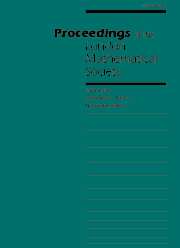Article contents
ON THE INFINITE RADICAL OF A MODULE CATEGORY
Published online by Cambridge University Press: 03 November 2000
Abstract
Let $k$ be an algebraically closed field, and let $A$ be a finite-dimensional $k$-algebra. The first aim of classsical representation theory was to classify all indecomposable $A$-modules, but the homomorphisms between modules were not considered. One big step forward, made around 1975, was the invention of the Auslander--Reiten quiver of $A$. The Auslander--Reiten quiver yields a description of the category of $A$-modules modulo its infinite radical ${\rm rad}_A^\omega$. But it contains no information about the homomorphisms in ${\rm rad}_A^\omega$. We denote by mod-$A$ the category of finite-dimensional right modules over $A$. Let ${\rm rad}_A$ be the radical of mod-$A$. Following Prest, we define ${\rm rad}_A^\alpha$ for each ordinal number $\alpha$ as follows: if $J$ is an ideal in mod-$A$ and $n \geq 1$ is a natural number, then $J^n$ is the $n$-fold product of the ideal $J$. For a limit number $\beta$ define ${\rm rad}_A^\beta = \bigcap_{\alpha < \beta} {\rm rad}_A^\alpha$. Finally, let $\alpha$ be an arbitrary infinite ordinal number. Thus $\alpha = \beta + n$ for some limit number $\beta$ and some natural number $n \geq 0$. In this case, define ${\rm rad}_A^\alpha = ({\rm rad}_A^\beta)^{n+1}$. We denote the first limit number by $\omega$, the second by $\omega 2$, and so on. The minimal limit number, which is not of the form $\omega n$ for some natural number $n \geq 1$, is denoted by $\omega^2$. {\sc Theorem 1.} {\it For each ordinal number $\alpha$ with $\omega < \alpha < \omega^2$ there exists a finite-dimensional $k$-algebra $A$ with ${\rm rad}_A^\alpha \not= 0$ and ${\rm rad}_A^{\alpha + 1} = 0$. Let $Q$ be a quiver, and let $I$ be an admissible ideal of the path algebra $kQ$. We call $kQ/I$ {\it special biserial} if the following hold. Any vertex of $Q$ is the starting point of at most two arrows and also the end point of at most two arrows. Given an arrow $\beta$, there is at most one arrow $\alpha$ with $e(\alpha) = s(\beta)$ and $\alpha \beta \notin I$ and at most one arrow $\gamma$ with $e(\beta) = s(\gamma)$ and $\beta \gamma \notin I$. {\sc Theorem 2.} {\it Let $A$ be a special biserial algebra. Then the following are equivalent: \begin{enumerate} \item[{\rm (i)}] $A$ is domestic; \item[{\rm (ii)}] ${\rm rad}_A^{\omega^2} = 0$. \end{enumerate} } 1991 Mathematics Subject Classification: 16G20, 16G60, 16N40
- Type
- Research Article
- Information
- Proceedings of the London Mathematical Society , Volume 81 , Issue 3 , November 2000 , pp. 651 - 674
- Copyright
- 2000 London Mathematical Society
- 18
- Cited by


